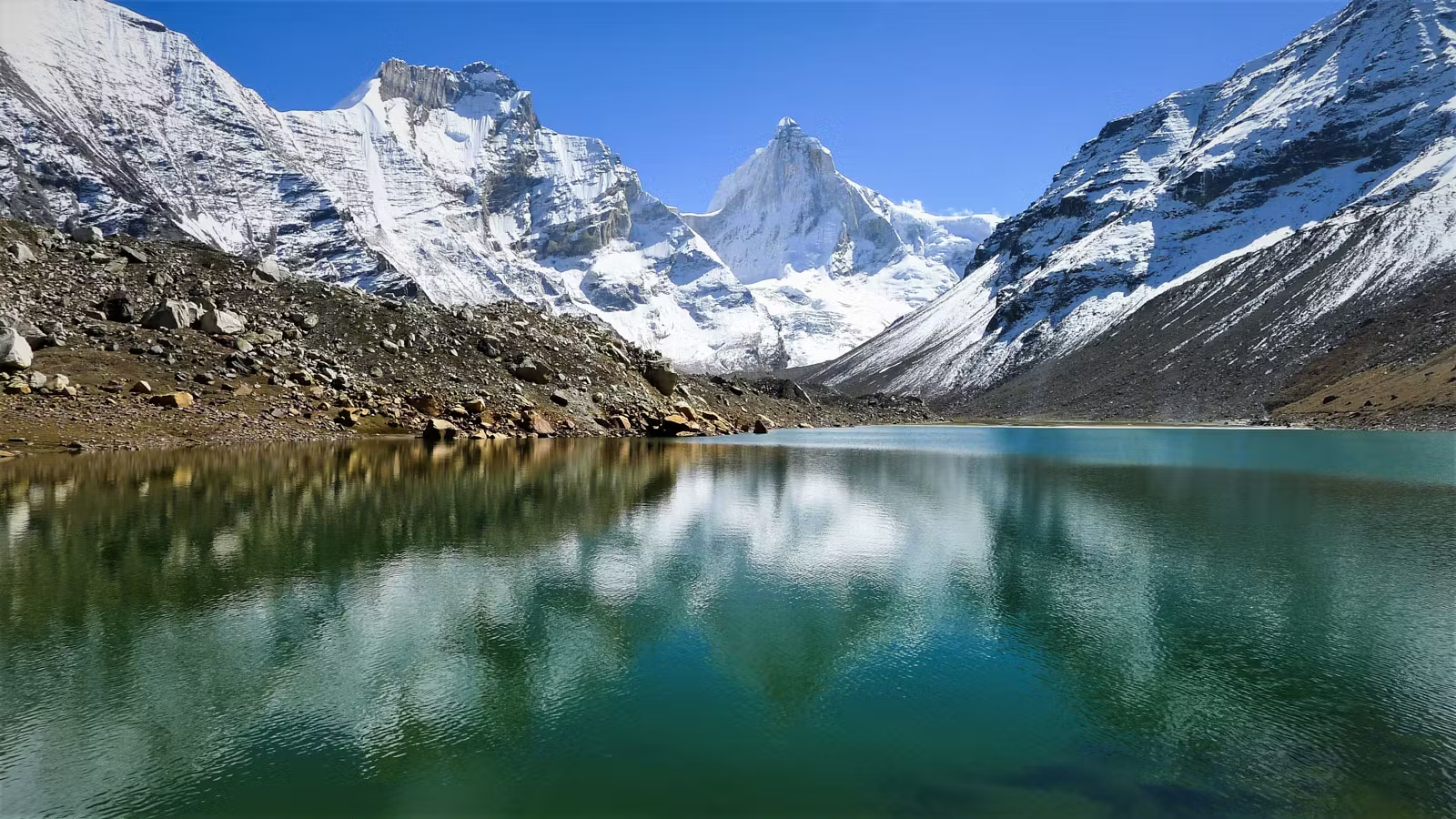

Kedartal Trek
A Rare Adventure Among Big Mountains
Have questions? Speak to our expert Trek Advisors
We have an expert team of Trek Advisors to help you choose the right trek. So if you have questions like, "Can I do this trek?" or "Who else is trekking?", please get in touch.Talk to our Trek Advisors
TREK DIFFICULTY
Difficult
TREK DURATION
7 days
HIGHEST ALTITUDE
15,500 ft
SUITABLE FOR
TOTAL TREK DISTANCE
22.4 kms

BASECAMP
Gangotri
ACCOMMODATION TYPE
Tents
PICKUP POINT
Trek Fee
₹
16,450
+5% GST
+ ₹210 Trek Insurance
Optional Additions
₹750 Indiahikes Shield
A Rare Adventure Among Big Mountains
The Kedartal trek is an adventure-seekers' dream. It is for trekkers who have explored the Himalayas and now want to push themselves further. This is no easy trek—it is challenging, demanding, and tests your limits. But the rewards? They are nothing short of magical.
Kedartal, a high-altitude glacial lake nestled at approximately 15,500 feet, offers an experience like no other. Standing at the lake’s edge is profoundly moving, with Mount Thalaysagar’s pyramid-like summit towering across the water. The sight of iconic peaks like Mt. Bhrigupanth, the Jogin sisters, and Mandar Parvat rising 6,000 to 7,000 meters high surrounds you with an unmatched grandeur. For many trekkers, the beauty is so overwhelming that it tears their eyes.
The trek begins at the pilgrim town of Gangotri, weaving through dense coniferous forests, overhangs, and loose scree trails. As you ascend to Bhoj Kharak, a cosy campsite tucked into the wilderness, and further to Kedarkharak at 14,500 feet, the changing landscapes are awe-inspiring. Here, the skies are a vivid blue, and the sunsets at Kedartal are spectacular, casting vibrant hues on the surrounding peaks.
Trek Fee
₹
16,450
+5% GST
+ ₹210 Trek Insurance
Optional Additions
₹750 Indiahikes Shield
Kedartal - Complete Trek Information
We have always wanted trekkers to be well-informed before they go on a Himalayan trek. Knowledge is the difference between a safe trek and a dangerous one. It’s also the difference between a wholesome experience and a superficial experience.
Use this section to learn about the Kedartal trek. It has in-depth information about each day of the trek, what to expect, and how you need to prepare for it. Many years of expertise have gone into this content. Trekkers find that extremely useful.
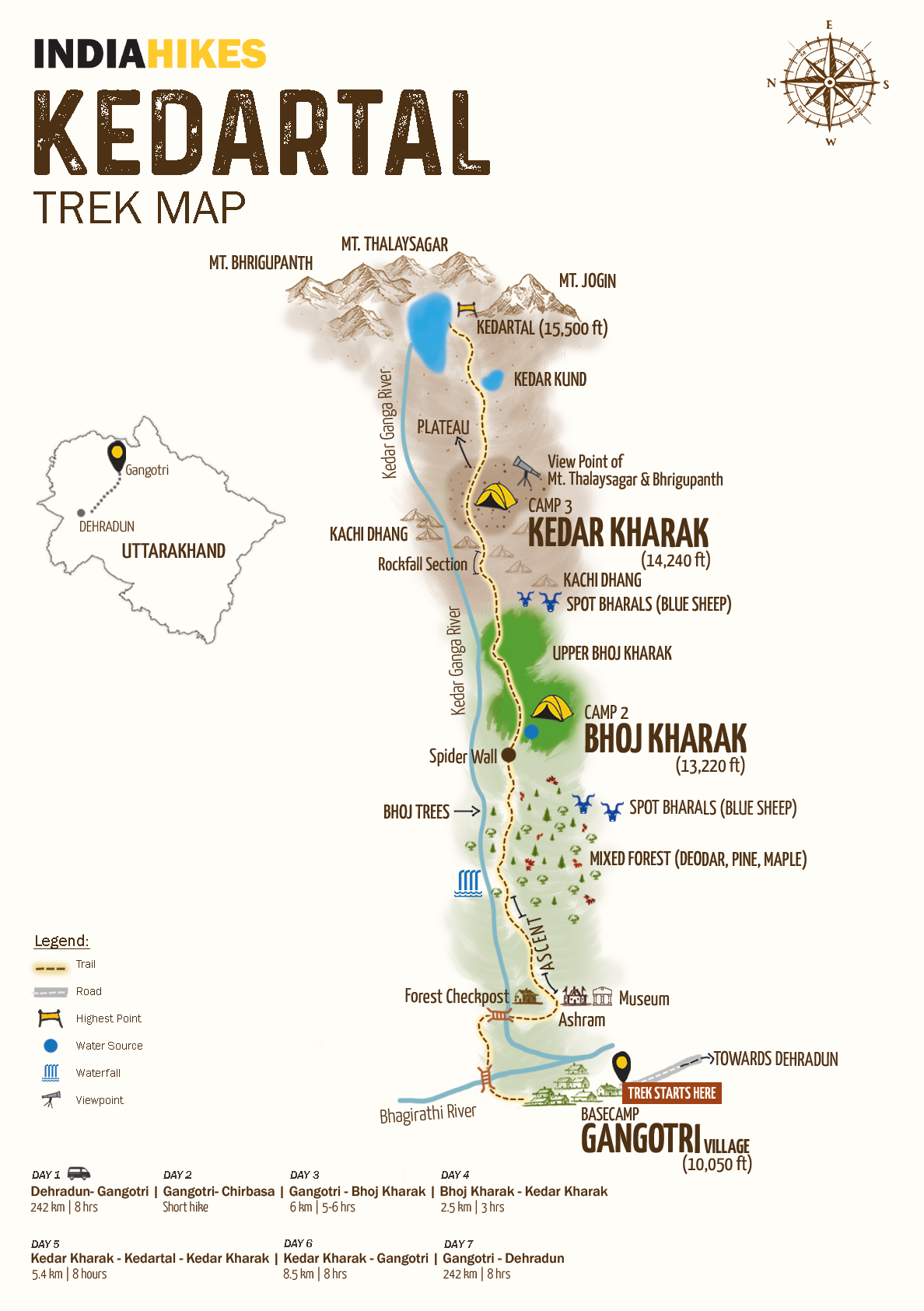
Study this map to get a visual cue of the Kedartal trek.
Day 1
Reach Gangotri from Dehradun
Drive distance: 242 km | Drive Duration: 8 hours
Transport will be arranged from Hotel Grand Legacy Dehradun at 6.00 am. The cab fare is Rs9,000 for an SUV and Rs 14,000 for a Tempo Traveller (seats 10-12 people). This is to be shared among trekkers and paid directly to the driver.
Day 2
Acclimatization day around Gangotri (10,052 ft)
Take a short trek up one of the trails around Gangotri and then return to base.
Day 3
Trek from Gangotri (10,052 ft) to Bhoj Kharak (13,220 ft)
Trek distance: 6 km | Trek Duration: 5-6 hours
Moderate-difficult. Steep ascent all the way. The terrain is rocky in many parts.
Day 4
Bhoj Kharak (13,220 ft) to Kedar Kharak (14,240 ft)
Trek distance: 2.5 km | Trek Duration: 3 hours
Moderate-difficult. 1 km of steep ascent followed by 3 km of moderate ascents and descents.
Day 5
Kedar Kharak (14,240 ft) to Kedartal (15,500 ft) and back to Kedar Kharak (14,240 ft)
Trek distance: 5.40 km | Trek Duration: 8 hours
Difficult. Continuously ascending trail over a rocky terrain.
Day 6
Kedar Kharak (14,240 ft) to Gangotri (10,052 ft)
Trek distance: 8.50 km | Trek Duration: 8 hours
Moderate. Continuously descending trail over a rocky terrain
Day 7
Gangotri to Dehradun
Drive distance: 242 km | Drive Duration: 8 hours
Cab cost per vehicle will be Rs 8,500 (Tempo Traveller) and Rs 14,000 (SUV). You will reach Dehradun between 6.00 PM and 7.00 PM.
Please note: The distance between campsites may vary by 100 meters depending the weather conditions and the route you take. The altitude may also vary by 100 feet for similar reasons.
IMPORTANT POINTS
- You will be staying in tents on all days of the trek.
- Trekkers must carry a copy of their photo ID for entry at forest check posts on the trek.











Day 1: Reach Gangotri

Drive Duration: 8 hour drive.

Altitude: 10,052 ft (3,064 m)

Difficulty: Moderate ascent. Well-marked road followed by forest trails.
The trek begins at Gangotri the following morning. Gangotri is known as the source of the river Ganga (the actual source being Gaumukh), which is known as Bhagirathi here.
It is said that King Bhagirath prayed to Lord Shiva for the salvation of the souls of his 60,000 sons. Shiva obliged and requested Goddess Ganga to release her water, which purified the ashes of Bhagirath’s sons. This mythological story elevated the status of the River Ganga as a means to purify one’s soul.




The trek begins at Gangotri the following morning. Gangotri is known as the source of the river Ganga (the actual source being Gaumukh), which is known as Bhagirathi here.
It is said that King Bhagirath prayed to Lord Shiva for the salvation of the souls of his 60,000 sons. Shiva obliged and requested Goddess Ganga to release her water, which purified the ashes of Bhagirath’s sons. This mythological story elevated the status of the River Ganga as a means to purify one’s soul.


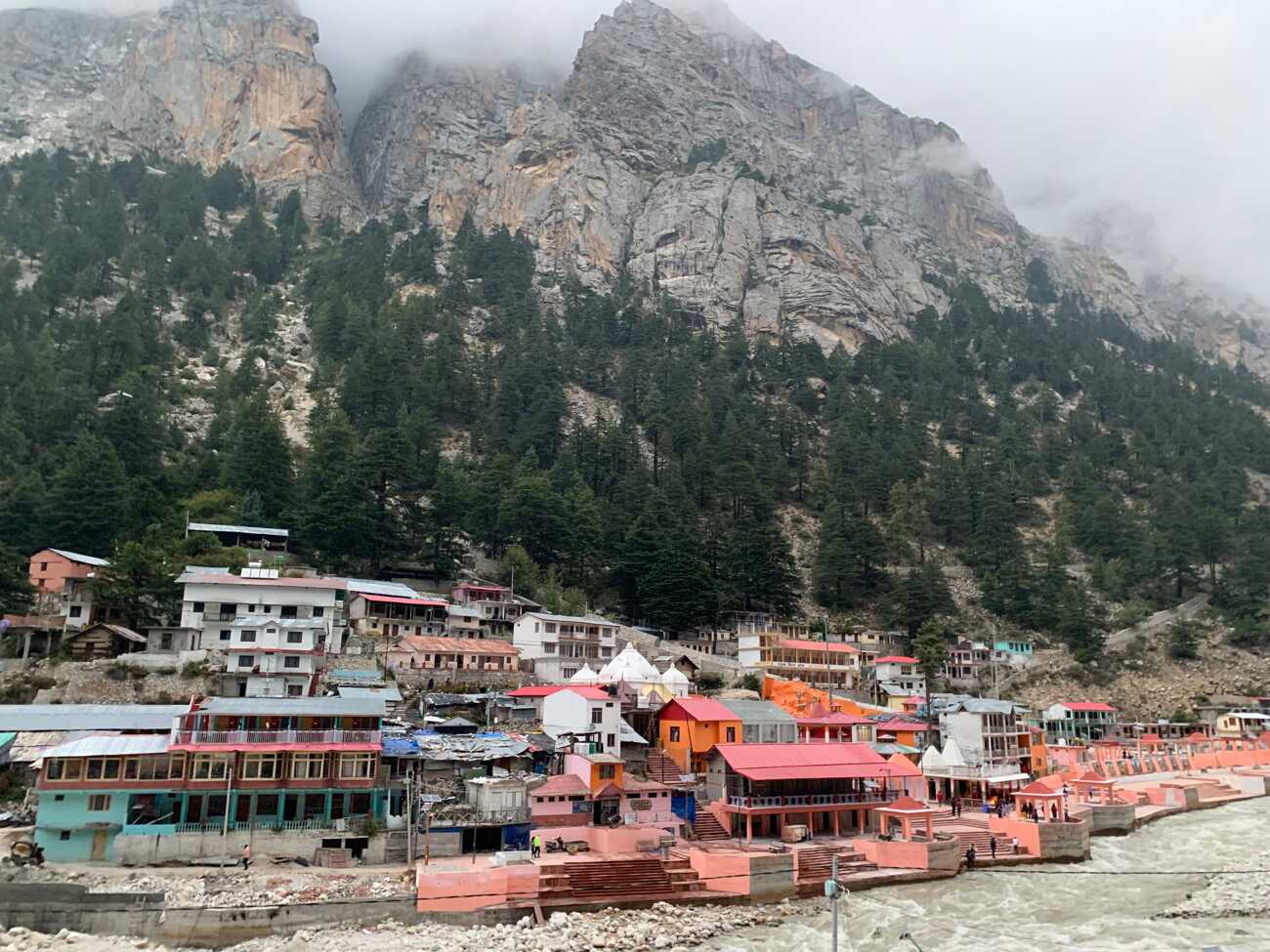








Day 2: Acclimatisation day in Gangotri



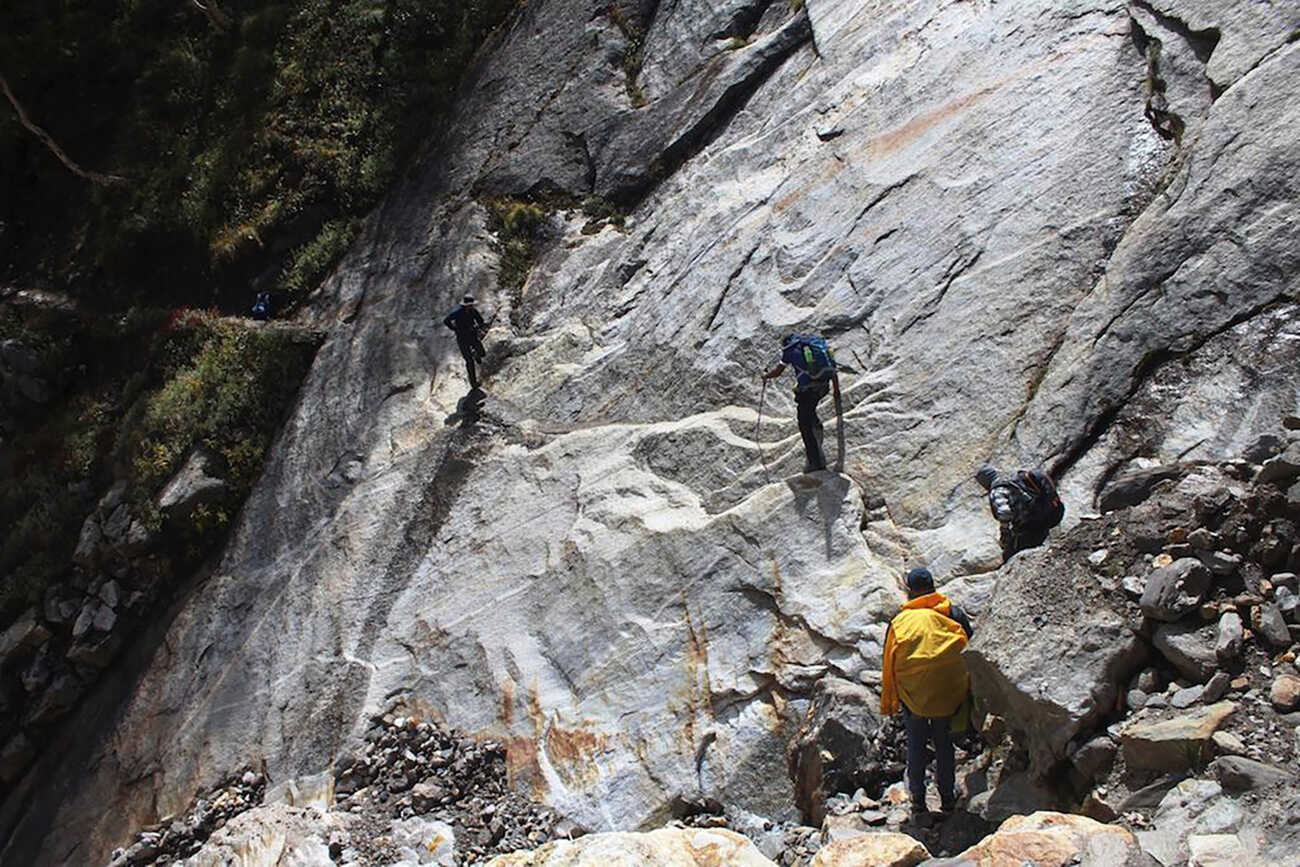







Day 3: Trek from Gangotri to Bhoj kharak

Trek Duration: 5-6 hours | Trek Distance: 6 km

Altitude gain ⇗: 10,052 ft Trek to 13,220 ft

Diifculty: Moderate-difficult. Steep ascent all the way. The terrain is rocky in many parts.

Water sources: Carry sufficient water. There are three sources on the way where you can refill your water bottles.
Walk into the Gangotri market. There are public washrooms here if you want to use them before setting off on the trek. Carry dry rations or packed lunch since there is no food available on this trail.
Around 50 meters from the washrooms, take the steps going down to the right towards the Bhairav Ghati bridge across the Bhagirathi river. The trail to Bhoj Kharak begins as soon as you cross the river. You will see a GMVN lodge to the right. You will also pass the ashrams of a few sages. The trail here has already begun to ascend.
After 200 meters, take a trail that climbs up sharply to the right, along the side of another ashram. This brings you to the forest trail to Bhoj Kharak. This frequently trekked route is the only path available to reach Bhoj Kharak. Here, the trail ascends steeply almost to Bhoj Kharak.




Walk into the Gangotri market. There are public washrooms here if you want to use them before setting off on the trek. Carry dry rations or packed lunch since there is no food available on this trail.
Around 50 meters from the washrooms, take the steps going down to the right towards the Bhairav Ghati bridge across the Bhagirathi river. The trail to Bhoj Kharak begins as soon as you cross the river. You will see a GMVN lodge to the right. You will also pass the ashrams of a few sages. The trail here has already begun to ascend.
After 200 meters, take a trail that climbs up sharply to the right, along the side of another ashram. This brings you to the forest trail to Bhoj Kharak. This frequently trekked route is the only path available to reach Bhoj Kharak. Here, the trail ascends steeply almost to Bhoj Kharak.
The trail is rocky in most parts. Being the first day of the trek, it is likely that you will struggle for your breath as lift yourself and your bag onto the rocks. Below you, you hear the KedarGanga river thundering past. Above you are branches of the fir trees you find in this forest. The valley becomes narrower as you go deeper. There are short stretches of flat walks that allow you to catch your breath but the climb is relentless.
After an hour and a half of climbing, the fir tree gives way to birch or bhoj. The barks of these trees shed thin sheets that resemble paper. Due to the durability and texture of this bark, most of our ancient Indian texts were written on it. The locals use it in their shoes as insulation from the cold.
Though the terrain is strenuous, ‘rhythmic trekking’ takes the edge off it. It is important to take small sips of water at equal intervals to keep well hydrated. The trail crosses three water points from where you can refill your water bottles.
After about four hours of trekking, the trail emerges out of the forest. Here, you get your first ‘spider wall’ or a narrow path on a near-vertical rock face. The trail has just enough space to keep afoot at a time. Focus on the next step and do not look down – you’ll be able to cross this path comfortably.
The trail climbs for another fifteen minutes before you reach the second spider wall. Cross this and you will reach the campsite within five minutes.
The BhojKharak campsite consists of small strips of land lying to the left of the trail. You will have to find flat stretches to pitch your tents. There’s wild grass growing around. The valley here is quite narrow so the view is not very great.
The closest water source is the stream flowing along the spider wall that you just crossed.











Day 4: Bhoj Kharak to Kedar Kharak

Trek Duration: 3-4 hours | Trek Duration: 2.5 km

Altitude gain ⇗: 13,220 ft to 14,240 ft

Difficulty: Moderate-difficult. 1 km of steep ascent followed by 3 km of moderate ascents and descents.

Water sources: Carry sufficient water. There are sources on the way where you can refill your water bottles.
The trek from Bhoj Kharak to Kedar Kharak is relatively simple compared to the previous day’s climb. Though there are a few grim patches, the terrain has uniform ascents and descents. The trek to Kedar Kharak, situated at 14,000 ft, is 4 km and takes about five hours.
The ascent is quite steep as soon as you set out of the campsite at Bhoj Kharak. After a 1 km trek through the Bhoj forests, the trail leaves the tree line and enters meadows which are multi colours in autumn – an astounding setting for photography with the snow-covered peak Bhrigupanth in the backdrop.
The next 2 km feel like a relaxing stroll as there are fewer steep ascents. It is in this stretch that you may get a chance to encounter high altitude fauna like Bharal (blue sheep), Goral, Himalayan black bear and a variety of birds.




The trek from Bhoj Kharak to Kedar Kharak is relatively simple compared to the previous day’s climb. Though there are a few grim patches, the terrain has uniform ascents and descents. The trek to Kedar Kharak, situated at 14,000 ft, is 4 km and takes about five hours.
The ascent is quite steep as soon as you set out of the campsite at Bhoj Kharak. After a 1 km trek through the Bhoj forests, the trail leaves the tree line and enters meadows which are multi colours in autumn – an astounding setting for photography with the snow-covered peak Bhrigupanth in the backdrop.
The next 2 km feel like a relaxing stroll as there are fewer steep ascents. It is in this stretch that you may get a chance to encounter high altitude fauna like Bharal (blue sheep), Goral, Himalayan black bear and a variety of birds.
The climate gets chillier as you gain altitude. Do not be surprised if you notice a thin layer of frost over the stones in the streams. After passing about two more water points you reach Kedar Kharak.
The camp is set on a vast dry meadow with a few sparsely distributed boulders beside a wide stream. The stony path through which the stream climbs is the trail for the Day 4 Trek.
It is an exceptional sight to watch the sunset at Kedar Kharak. As the red ball of fire sinks behind the snow-clad Bhrigupant the entire meadow looks orange and turns grey at dusk.











Day 5: Kedar Kharak to Kedar Tal and return to Kedar Kharak

Trek Duration: 6 hours | Trek Duration: 5.4 km

Altude gain ⇗: 14,240 ft (4,340 m) to 15,500 ft (4,720 m) and back to 14,240 ft (4,340 m)

Difficulty: Difficult. Continuously ascending trail over a rocky terrain.

Water source: Carry 2 litres of water. There are no water sources on this day.
On this day the excitement level among the trekkers is usually at its peak, with the eagerness to make it to the emerald lake taking over any exhaustion from the previous day’s treks.
Start early as this stretch is the most laborious of all. At a height of 16,116 ft, the ‘Tal’ is a 5 km slog from Kedar Kharak through rocky mountains with absolutely no greenery around.
Despite the barrenness, the terrain can be quite exhilarating. With vigorous ascents and very few descents, it demands a great deal of energy and effort to be able to reach the destination on time, considering the unpredictable weather conditions, with the probability of snow and rain being quite high during this season. The trail can best be described as a rocky maze with just one or two small streams that are not close by, thus requiring us to carry adequate water supplies.




On this day the excitement level among the trekkers is usually at its peak, with the eagerness to make it to the emerald lake taking over any exhaustion from the previous day’s treks.
Start early as this stretch is the most laborious of all. At a height of 16,116 ft, the ‘Tal’ is a 5 km slog from Kedar Kharak through rocky mountains with absolutely no greenery around.
Despite the barrenness, the terrain can be quite exhilarating. With vigorous ascents and very few descents, it demands a great deal of energy and effort to be able to reach the destination on time, considering the unpredictable weather conditions, with the probability of snow and rain being quite high during this season. The trail can best be described as a rocky maze with just one or two small streams that are not close by, thus requiring us to carry adequate water supplies.
If not careful, one can easily get turned around and it takes a while to realise that the route is off beam. For this reason, a lot of cairns ( piles of stones) have been placed en route to the Tal to point in the right direction. Watch your step as there are plenty of loose rocks on the way. After about 5- 6 hours of trekking, and half a kilometre away from the lake, you can see the mighty Thalaysagar Peak across a rocky ridge.
Once you cross this steep ridge, the descent to the lake begins. The temperature falls drastically at Kedartal. You can see the flawless reflection of the mighty old Thalaysagar peak on the Tal. Though the water is freezing, it is quite an experience to wet your fingertips in the emerald green lake. Spend some time here and soak in the scenery before turning back to Kedar Kharak on the same route.











Day 6: Kedar Kharak to Gangotri

Trek Duration: 7-8 hours | Trek Distance: 8.5 km.

Altitude loss ⇘: 14,240 ft to 10,052 ft

Difficulty: Moderate. Continuously descending trail over a rocky terrain

Water sources: Carry sufficient water. There are few sources on the way where you can refill your water bottles.
Day 7: Return to Dehradun

Drive Duration: 8 hours | Drive Distance: 242 km
The cab fare is Rs 8,500 (Tempo Traveller) and Rs 14,000 (SUV). You will reach Dehradun between 6.00 PM and 7.00 PM.
The cab fare is Rs 8,500 (Tempo Traveller) and Rs 14,000 (SUV). You will reach Dehradun between 6.00 PM and 7.00 PM.

Difficult
Suitable for Experienced Trekkers
You will cover a total of around 22.4 km in five trekking days during which you will gain approximately 5,450 ft (10,050 ft to 15,500 ft). Every day will include steep ascents or descents and boulder sections. There are several difficult sections on this trek that require you to be alert and trek carefully.
Terrain:
- Right from the time you begin your trek, there is a steep ascent. Very few treks in the country start like this. You gain 2,000 ft almost instantaneously and the climb is nearly 45-50 degrees.
- You trek through pine and birch forests until you reach the spider wall section. The spider wall section is a steep rock face that is almost at an angle of 90 degrees. You traverse this section on the first day itself.
- On the second day’s trek, just as you start, within 400 m, there is a rockfall zone. It is basically a scree section, and you need to navigate a steep descent here. Soon after this, there is a river crossing as well.
- The summit day is not as difficult as the previous two days, but the sheer altitude makes it challenging. The final ascent to the glacial lake is extremely steep.
- The return from Kedar Kharak to Gangotri is similar to your first day’s trek. You trace the route back. You approach the rockfall section at Kedar Kharak once again. Except that this time, you are descending. There is also an extremely slippery scree section, so descending is a challenge.
Please note: If you are trekking with Indiahikes, our Trek Leaders and Technical Guides will provide you with all necessary guidance, support, and technical gear such as micro spikes, gaiters, helmets, ropes, etc. wherever required.
Weather:
- Rainfall or snowfall, lasting for hours, can change the entire trek dynamic. Rain can flood the trails or make them too slushy to walk safely on.
- Snowfall can obstruct previously made paths, requiring fresh tracks to be cut on the snow.
- In the Autumn season, the temperatures plummet below zero. Even without snowfall, strong winds can take a toll on you if you're not well-layered.
Please note: The safety of our trekkers is paramount. Our technical team, in conjunction with the Trek Leader, constantly monitors the weather conditions and makes informed decisions about proceeding with or aborting the trek. If the weather deteriorates, the team may need to turn back from any campsite to ensure the safety of all trekkers.
Altitude:
- Gangotri, situated 10,050 ft above sea-level, is our highest basecamp. Even with an extra day factored in for acclimatisation, you are prone to Acute Mountain Sickness (AMS) on this trek.
- Starting from Gangotri, you gain another 3000 ft on the first day of the trek itself. This is challenging for any trekker.
- At altitudes above 10,000 ft, the chances of being hit by Acute Mountain Sickness are real. Altitude sickness can happen to anybody - first-time trekkers as well as experienced trekkers. Fitness helps in making your trek easier. But do not forget that even a fit person climbing too high too soon runs an equal risk of developing AMS. Here’s a Complete guide to Acute Mountains Sickness, HAPE and HACE
Please Note: The Indiahikes team is equipped with high-altitude medical kits, oxygen cylinders, and stretchers to handle any altitude-related emergencies.
Emergency Exits:
- The only exit point on the Kedartal Trek is Gangotri (basecamp). With only one exit point on the trail, evacuation in case of emergency becomes challenging on the Kedartal Trek.
Closest Hospital to the Kedartal Trek:
There is a Primary Health Care Center in Harsil, about 25 km from Gangotri However, it has very basic facilities. For better facilities, you need to approach the District Hospital in Uttarkashi, which is about 100 kms by road from Gangotri. However, for any advanced treatment, heading to Dehradun is the best option.
The Indiahikes team will ensure your safety throughout the journey. However, we believe that safety is a shared responsibility. We need your active participation and attention to safety protocols to ensure a safe and successful trek.
On the first day of the trek, you negotiate this steep rocky section, popularly known as the spider wall. Photo by Padmanava. In the early months of spring, Kedartal is often blanketed in snow. This makes the trek even more challenging, with some sections becoming completely inaccessible. Photo by Aarnav Subbaramu. You traverse several narrow ledges on your trek to Kedartal. Photo by Bhupinder. In late autumn, expect snow on the trail. Snow and ice make the paths slippery, adding several layers of challenge to the trek. Photo by Satyen Dasgupta.
Please inform your Trek Leader about any pre-existing medical conditions or health concerns, no matter how minor they may seem. This will enable us to take the necessary precautions and ensure your safety throughout the trek.
We recommend walking/jogging/running as the best routine to get fit for any trek. It works on the same muscles you use while trekking—your calves, glutes, quads and hamstrings. It also mimics your foot movement so you are better prepared for sudden twists and turns they may go through on uneven terrain.
It helps increase your stamina gradually if done consistently. It is also an easy routine that does not require any equipment or tools.
Fitness Target
To do the Kedartal Trek comfortably, you must be able to walk, jog or run 10 km in under 60 minutes. This is the minimum recommended fitness level that you must aim for.
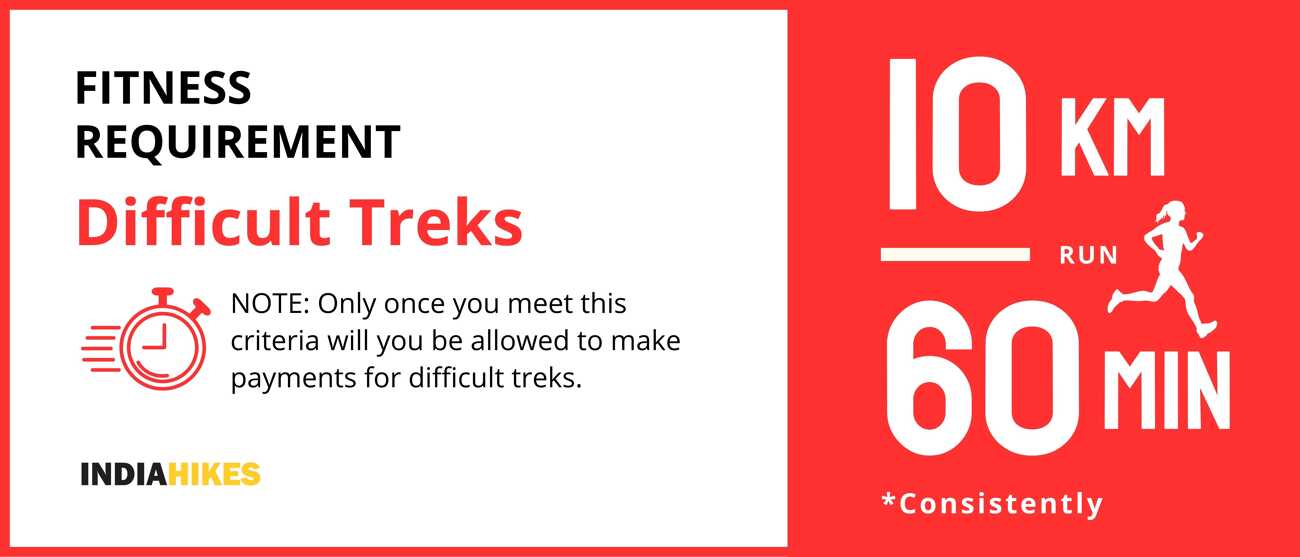
Trekking is a sport that primarily uses your lungs, core, calves, glutes, quads and hamstrings. Being fit will help you enjoy the trek and will keep you safe.
To reach any fitness target, there are two things you must work on:
- Cardiovascular endurance
- Muscle strength
If you are not currently active, follow the below schedule to get trek-fit in 6 weeks!
A 6-Week Plan to Help You Get Trek-Fit for the Kedartal Trek
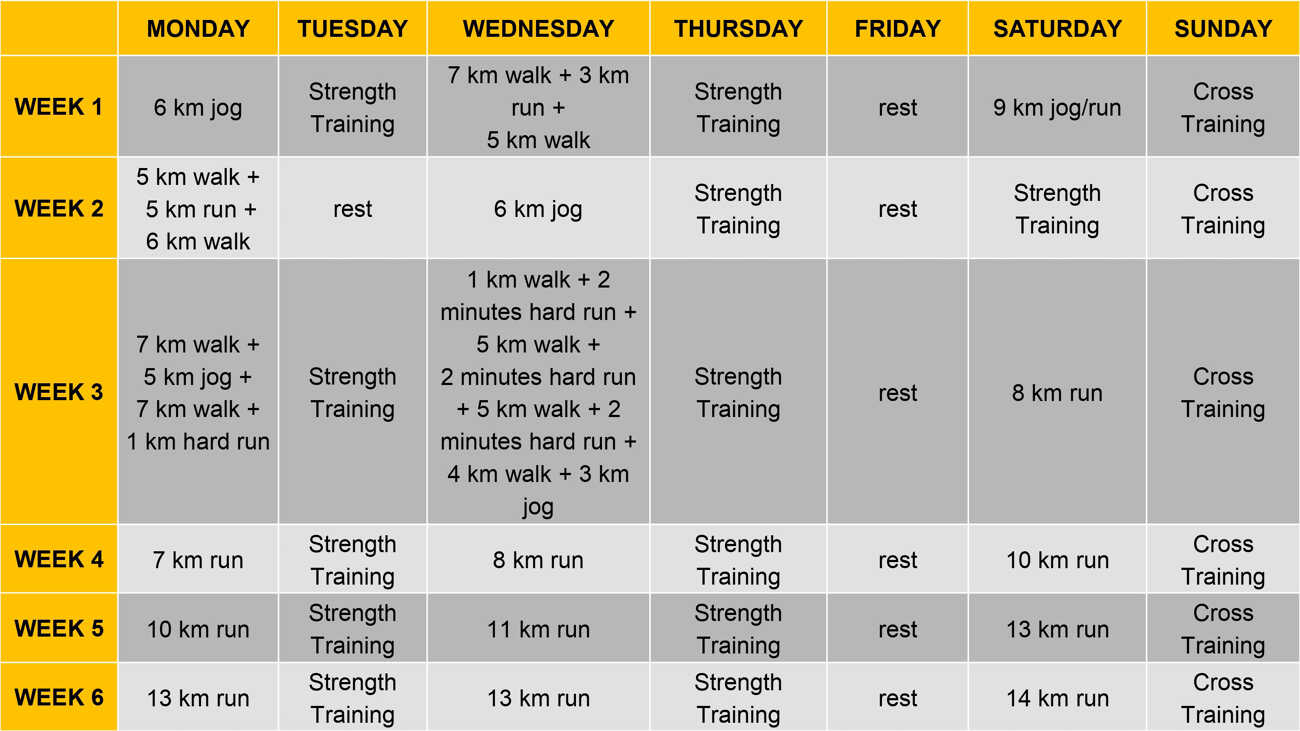
Pro Tip: Warming up and cooling down before and after your workout is important. Do not miss that.
| Note: If you are not a regular runner, do not start running all of a sudden.
Strength Training Schedule:
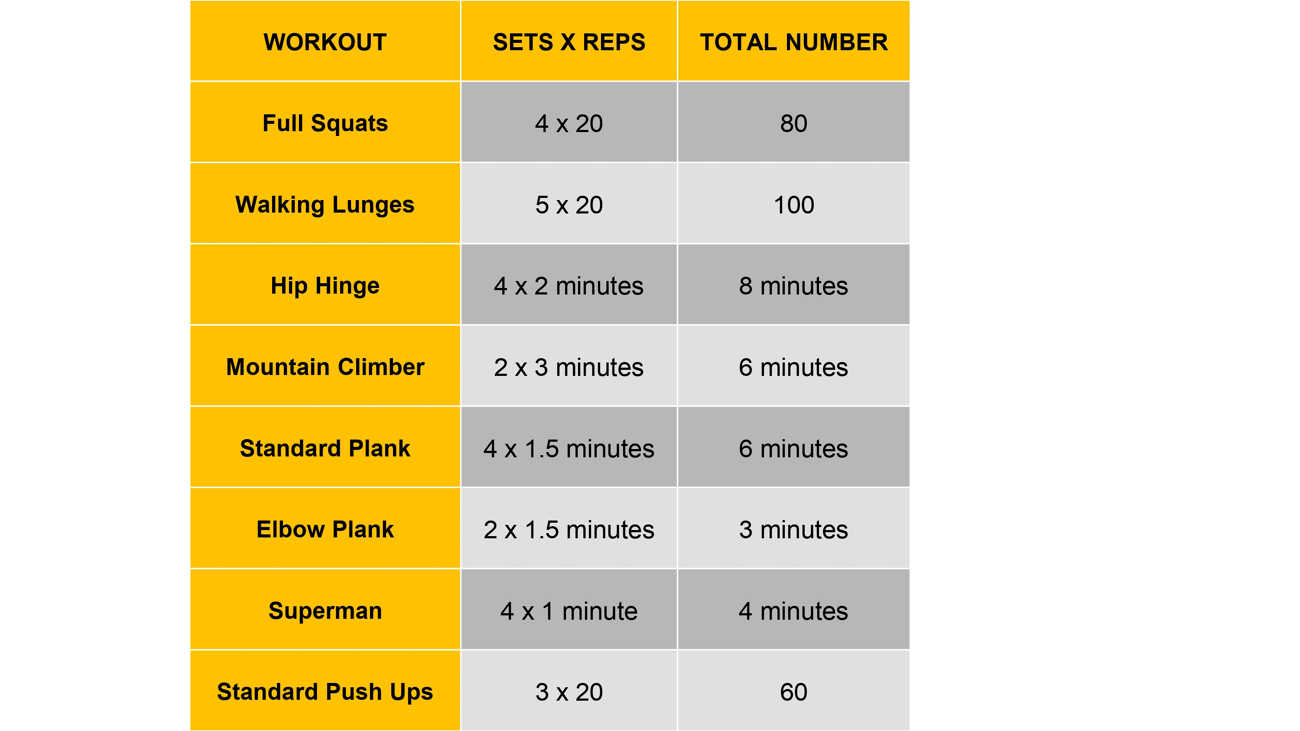
Note:
- Alternatives to 60 Standard Pushups = (4 x 25 = 100 knee pushups) = (4 x 50 = 200 wall pushups)
- Alternative to 80 full squats = (4 x 40 = 160 half squats)
- Alternative to jumping lunges = forward lunges (same count)
- If you are not able to complete 1 full set of any plank, divide it into 2 halves and complete it with a rest break in between. For example: If you are not able to complete 1 minute of a standard plank, divide it into 2 sets of 30 seconds each.
- After completing a few weeks of training, if you can progress, you may increase the number of sets or reps for desired results.
Important note: We accept only running, jogging, or walking workout screenshots as fitness proof. Screenshots of cross-training workouts will not be considered valid. We've suggested cross-training options to help keep your fitness journey engaging and fun, allowing you to explore activities you enjoy and avoid inconsistency.
Note: Use apps like Nike and Strava to record your runs.
What happens if you are not fit:
- You do not enjoy the trek
- You struggle to be a part of the team because you’re slow.
- You miss out on a deep, transformative experience that Indiahikes specially designs for you.
The good part is it is not difficult. All you need to do is start following the fitness routine 6 to 8 weeks before your trek begins.
We are here to help you in this fitness journey. Just start slow and as long as you are committed and consistent with your routine, you are in for an unforgettable trek experience.
How to Get Fitness Approval from the Indiahikes Team:
Every trekker needs fitness approval from the Indiahikes team 20 days before the trek date. Without this, you will not be allowed on the trek.
Note: Use apps like Nike and Strava to record your runs.
What to upload?
- A minimum of 3 screenshots of your runs/jogs/walks/cycling
- Monthly summary of your routine
Kedartal in Summer (mid-May to end-June)
 Day Temperature: The day temperatures are pleasant at an average of 15 – 20 °C | Night Temperature: Nights can get cold, with the mercury dropping close to zero degrees. When it rains or snows, expect the daytime temperature to drop below 10 °C.
Day Temperature: The day temperatures are pleasant at an average of 15 – 20 °C | Night Temperature: Nights can get cold, with the mercury dropping close to zero degrees. When it rains or snows, expect the daytime temperature to drop below 10 °C.
 Rain/Snow in summer: The weather is quite unpredictable and volatile during the summers. The weather changes unannounced and it could abruptly start raining or even snowing.
Rain/Snow in summer: The weather is quite unpredictable and volatile during the summers. The weather changes unannounced and it could abruptly start raining or even snowing.
 Number of warm layers recommended in Summer: 3-4 warm layers
Number of warm layers recommended in Summer: 3-4 warm layers
Summer is the most popular time to do the Kedartal trek as a big attraction in early summers is to find the Kedartal lake completely frozen. This is a rare sight. You don’t get to see a frozen lake right in the middle of huge mountains.
In contrast, the view of Mt Thalaysagar and Mt Bhrigunath with the blue sky and snow-capped mountains is exceptional!
Another big attraction at this time is the presence of snow on the trail. In May, you’ll find a good amount of snow after Kedar Kharak on the way to the summit. You will also find patches of snow before you reach Kedar Kharak, especially in the shadows of the mountains, patches where direct sunlight cannot reach.
While the presence of snow makes the trek challenging, it also adds an extra dose of adventure to the trek.
But here’s something you must keep in mind while trekking to Kedartal in summer – the months of May-June are susceptible to bad weather. Remember that the trek lies in the lap of the Greater Himalayas, and at such altitude, you can expect it to snow even in summer.
When it snows the campsites turn completely white. The white powdery snow glistens in the summer sun. It is something to watch out for.
Look how the Kedar Kharak campsite looks when it snows in the summer.
By the end of June, the arrival of monsoons is imminent. This makes the trail prone to landslides and rockfalls. The trek becomes a risky proposition to undertake.
Therefore, at Indiahikes, we wind up the summer season by June.
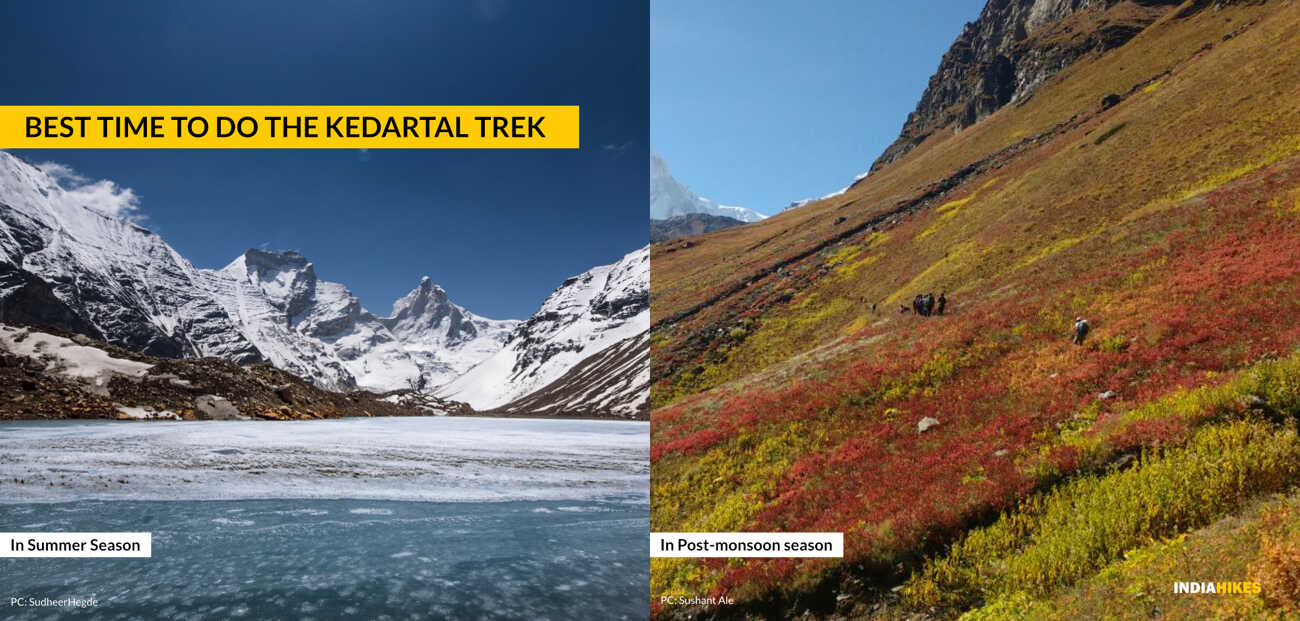
Kedartal in Autumn (mid-September to mid-October)
 Day Temperature: Days can be quite warm with temperatures going as high as 20 °C | Night Temperature: The evenings at the campsite can get cold. Don’t be surprised if the temperatures fall below zero at night. Expect the overall temperatures to fall by 3-5 °C every couple of weeks as the season progresses.
Day Temperature: Days can be quite warm with temperatures going as high as 20 °C | Night Temperature: The evenings at the campsite can get cold. Don’t be surprised if the temperatures fall below zero at night. Expect the overall temperatures to fall by 3-5 °C every couple of weeks as the season progresses.
 From October, any precipitation comes down as snowfall in the higher camps. When it snows, expect 3-4 inches of snow. The initial bouts of snow tend to melt away in the sun. By the end of October, the cold increases manifold, water sources freeze and trekking becomes untenable.
From October, any precipitation comes down as snowfall in the higher camps. When it snows, expect 3-4 inches of snow. The initial bouts of snow tend to melt away in the sun. By the end of October, the cold increases manifold, water sources freeze and trekking becomes untenable.
 Number of warm layers recommended in Summer: 4-5 warm layers
Number of warm layers recommended in Summer: 4-5 warm layers
The setting shifts radically if you happen to trek to Kedartal in autumn. In September-October, the summer haze and clouds clear up to reveal brilliant mountain views.
After the monsoon, when the sky shakes off all the clouds and becomes squeaky clean, you see the best views of the mountains around. And there are many mountains to look at.
Being in the Gangotri region, this trail is surrounded by big mountains in all directions. Getting to see these mountains from such close quarters against the backdrop of a clear sky brings tears to many trekkers’ eyes.
Even the views can’t get any better than at the summit. The lake now completely still looks a shade of blue or emerald green depending on the weather. When the water is still you’ll see a complete reflection of mighty Mt. Thalaysagar reflecting in its blue-green waters.
Another thing to watch out for during autumn is the snow plumes. When heavy winds blow at the top of the mountain, the snow is dispersed in the air to form a shape resembling a plume on a hat. Hence the name snow plumes.
Although the trek is quite desolate, the little bit of vegetation does add colour to the trail. The silver birch trees turn a golden shade of yellow, while the trunk shines in the bright autumn sun.
Kedar Kharak campsite is one such campsite. Pause here to experience this riot of colours. The shrubs on the sides of the mountains also turn into autumn colours of yellow, brown and maroon.
It’s also the time you’ll see the mountain goats – the Bharal. Though this is their natural habitat, it is rare to see them. The probability of sighting them is higher in autumn. Keep an eye out along the sides of the mountains feeding on the shrubs. Keep your fingers crossed too.
An important thing to note during the autumn season is the lack of reliable water sources on the trail. Water sources en route tend to dry up. Therefore always leave camp with 2-3 litres of water.


Given below is a list of all the gear you need for the Kedartal trek:
If you don’t have certain items, you can rent high-quality gear like trekking shoes, backpacks, and jackets from the Crosstrek Rental Store by Indiahikes. It costs less than Rs 2000 for the entire trek. We highly recommend renting gear since it is both more affordable and environmentally friendly.
Additionally, you’ll notice a small medical kit in the list. While our trek leaders carry medical kits with 17 medicines including life-saving drugs, you must bring your personal medical kit as well. We are already equipped with BP machines, oximeters and canned oxygen, but your medical kit is for quick access to you, especially while travelling.
Most importantly, you must digitally upload and carry mandatory documents to get government permits for the trek - your ID card & medical certificate. Keep them in a plastic bag to keep them safe in your backpack. There are no printing or photocopy facilities at the basecamp.
Here is a list of everything you need for your trek.
Shoes and backpack
- Trekking shoes with ankle support (Available on rent)
- Backpack with rain cover (Available on rent)
Warm Layers and Clothes
- Warm layers (Padded jackets available on rent)
- 3 layers if you're trekking in spring, summer and monsoon (1 woollen sweater, 1 fleece, 1 padded jacket)
- 4 layers if you're trekking in autumn (1 woollen sweater, 2 fleece, 1 padded jacket)
- 5 layers if you're trekking in winter (1 pair of thermals, 1 woollen sweater, 2 fleece, 1 padded jacket) - 3 Collared T-shirts (Wear one, carry two)
- 2 quick-dry trek pants (Wear one, carry one)
Accessories
- Sunglasses (Available on rent)
- Sun cap, preferably with flaps
- Waterproof gloves (Available for purchase)
- Balaclava
- Woollen socks (2 pairs of Dry fit + 1 pair of Woollen)
- Headlamp (Available on rent)
- Trekking pole (Available on rent)
- Rain jacket + pants / poncho (Rain Jacket is available on rent)
Toiletries:
- Sunscreen
- Moisturiser
- Light towel
- Lip balm or vaseline
- Toilet paper (Wet wipes are strictly not allowed on our treks)
- Toothbrush
- Toothpaste
- Reusable plastic covers (for used clothes)
Cutlery:
- Steel lunch box, spoon and a coffee mug (Lunch box is available on rent)
- Two water bottles or Hydration Pack (Water bottles are available on rent)
Once you run through this list, don't miss this ultimate guide on what gear to take on a trek. It contains tips on what gear to choose, where to get it from and how much to spend on it.
Our only tip: Keep your backpack light. Indiahikes practices low impact sustainable trekking in every aspect of the trek. Carrying your own personal backpack reduces your impact on the mountains by 20%. We expect all our trekkers to carry their own backpacks unless they have a justifiable reason not to.
PRO TIPS
Keep important documents in a clear plastic cover and slide them into the inner pocket at the back of your backpack. This keeps them from getting wet.
These are documents required for legal purposes by Indiahikes and the forest department. Without any of these, you will not be allowed to trek.
- Original and photocopy of identity card. Anything such as a driver’s license, Aadhar Card, or passport will do. This is required by the forest department for your identification.
- 1 passport-size photograph. This is required to obtain the trekking permits
- Disclaimer certificate: You don't need to print or carry the disclaimer form. Your Trek Leader will give it to you at the base. Just sign and hand it over then and there.
However, if you are a minor unaccompanied by your parents, please download this disclaimer, print it, get it signed by your parents/guardian and carry it to the basecamp. – Download disclaimer certificate - Medical certificate: The medical certificate needs to be filled out by an MBBS doctor, without which the forest department will not issue permissions for your trek. It is also a requirement by Indiahikes – Download medical certificate
Note: Indiahikes has a panel of doctors who can help you with a medical certificate. They are available for online consultation. To get in touch with them, please write to trekmedicalcertificates@gmail.com. They will respond to you within 24 hours.
Consultation fee: Rs 300
Carry these medicines with you, easily accessible at all times. Do not take any medicine unless you have consulted your trek leader.
- Diamox (1 Strip): Be on a course of a half tablet of Diamox starting from Delhi every 12 hours (125 mg). Carry on the medication until you descend on the last day. Being on a preventive course of Diamox greatly reduces the chances of Acute Mountain Sickness on the Kedartal trek.
- Dolo 650 (5 tablets): This is a paracetamol. It helps to tackle fever, mild pain
- Avomine (4 tablets): Carry this especially if you are prone to motion sickness. Pop one-half hour before the start of your road journey.
- Combiflam (5 tablets): Take a combiflam if you get a sudden twist of the leg or a muscle strain. It is a pain reliever. It also contains paracetamol.
- Digene (4 tablets): Take it if you feel the food that you’ve taken is undigested. Alert your trek leader immediately. It could be a sign of AMS.
- ORS (6 packs): Consume a pack of ORS water at least once a day, usually mid-day when you are in the middle of your trek. It replenishes essential salts lost while trekking. Tip: It also makes cold water easier to drink.
- Knee Brace (optional): Carry this if you are prone to knee injury or have known issues of knee pain.
Our trek leaders carry a high altitude medical kit with them which also consist of Life Saving Drugs. If there is an emergency our trek leaders know how to tackle it. Meanwhile, contact your trek leader before consuming any of these medicines listed here.
| Pro tip: We find that these medicines by trekkers are rarely used. But you cannot do away with them. At the end of the trek please donate unused medicines to your trek leader. Some of these medicines get distributed to villages on the trek and some are added to the Indiahikes medical kit.
Gangotri is the base camp for the Kedartal Trek.
Gangotri, a bustling temple town situated more than 10,000 ft above sea level, is one of the four sites in the Char Dham pilgrimage of Uttarakhand. It is around 250 km from Dehradun and takes 9-10 hours by road.
On Day 1, our Indiahikes team will pick you up at 6.00 am from the Grand Legacy Beacon Hotel, near Laal Pul, Dehradun.
Arrive in Dehradun by Day Zero, which is one day before Day 1 on the itinerary. For example, if the Day 1 of your trek is 25th August, book your tickets to reach Dehradun by 24th August.
Here is a detailed guide to help you plan your travel to Dehradun:
How to reach Dehradun? Dehradun has its own airport and is well-connected to all major cities. The easiest way to reach Dehradun is to:
- Fly directly to the Jolly Grant Airport in Dehradun.
- Fly to Delhi and then take an overnight bus to Dehradun.

How to reach Dehradun by Flight:

Pro Tip: If the direct flights to Dehradun are too costly, fly to Delhi and take the overnight bus to Dehradun.
Flying to Delhi may be a lot cheaper than getting to Dehradun. However, If you notice the difference in air ticket prices between Delhi and Dehradun is less than Rs 1000 then book directly to Dehradun. The rest and shorter travel time are worth the difference.
How to reach Dehradun by Train:
We have listed down the most reliable trains running between Delhi and Dehradun.

Pro Tip: If you are reaching Dehradun by train, make sure you reach one day before your pick-up from Rishikesh. You must arrive at Dehradun on Day 0 (one day before your trek starts) and not on Day 1. It will give you the much needed rest before you start the long drive to Raithal the next day.
How to plan your return journey from Dehradun:
You can retrace the same journey back from Dehradun to your city. But keep the following points in mind:
- Book your return ticket only after 8-9 PM on the last day of your trek. However, we recommend that you add a buffer and travel the next day to safeguard your travel plans from unforeseen delays on mountain routes.
- If you’re taking an overnight bus to Delhi, keep enough buffer time to reach the airport. We recommend flights only after 11.00 AM.
If you have not opted for Indiahikes Transport and want to travel to Gangotri on your own:
There are no direct buses from Dehradun to Gangotri. You first need to reach Uttarkashi and then take a shared jeep to Gangotri.

Direct Bus from Dehradun to Uttarkashi and Shared Jeep to Gangotri
- There is one direct bus from Dehradun to Uttarkashi which leaves at 5:30 AM.
- You can book seats on this bus online through the UTC Pathik App. Please note that this bus departs from the Dehradun Hill Bus Stand and not from Dehradun ISBT
- It reaches Uttarkashi around 11:30 AM.
- From Uttarkashi Bus Stand, walk to the Taxi Stand.
- The shared vehicles for Gangotri leave from Uttarkashi Taxi Stand from early in the morning till 12 noon. It takes around 2.5 hrs to reach Gangotri from Uttarkashi.
Kedartal is a difficult trek. There are a few reasons why the Kedartal is considered difficult:
How Difficult Is The Kedartal Trek | Indiahikes | Tips To Prepare | Trek Talk With Vishnu Benne
- Altitude. The trek climbs up very quickly to the highest altitude of 15,500 ft, which is a very high altitude. You have hardly three days to climb this altitude, which makes you prone to the risk of Acute Mountain Sickness. (See – AMS on Kedartal Trek)
- Snow. The presence of snow on the trails leading to Kedartal makes the trek quite difficult to navigate. Especially in May and June.
Tricky Sections. There are several tricky sections on the Kedartal trail that make it difficult. There are the infamous spider walls on this trek, which are near-vertical boulders along which you have to traverse. Navigating these sections requires sure-footedness and measured footsteps. This comes in only with prior experience
A Himalayan trek like Kedartal requires a good fitness level. It has steep ascents daily. As a measure of your fitness, we need you to:
Run at least 5 km in 30 minutes & 10 km in 62 minutes before your trek. Consistency of your workout also matters, so aim to jog 30 km a week or 150 km in a month. It's our minimum mandatory requirement.
After you register, you will be sent a questionnaire about your trekking experience and medical history. Additionally, you must attach a screenshot of a 5 km run under 35 mins only to get approved for the trek.
High-altitude trekking experience of above 14,000 ft or at least moderate-difficult trek experience is a preferred requirement.
Once you get confirmed for your trek, we will diligently follow up on your fitness routine. Our team will also assist in putting you through a fitness plan. It will ultimately help you have a safe trek experience.
Before you register for the trek, we would like you to understand the challenges, and the fitness required.
On Difficult treks, you’re likely to trek around 12-20 km each day. Expect extremely steep ascents and descents, and maximum altitudes above 15,000 ft which can go up to 19,000+ ft. Technical sections (such as rockfall zones, near-vertical sections, glacier walks, boulder and scree sections) are an everyday affair. Some sections can only be crossed with the help of our Technical Staff.
Difficult treks are the most demanding, which is why we take only those trekkers with prior trekking experience on them.
To do a difficult trek, target running 10 km within 60 minutes consistently. This will be possible only if you can run 5 km within 30 minutes comfortably before signing up for a difficult trek.
This fitness chart will help you get there by following the plan for 8 weeks (or 2 months) before the start of your trek.
You will receive a questionnaire asking for your current fitness level and high altitude experience. Only those who have prior high altitude trekking experience will be allowed to sign up for difficult treks.
If you’re above the age of 58 years, you’ll also need to submit your Treadmill Test within 7 days of completing your registration.
Kedartal is a 30 km trek starting from Gangotri to Kedartal and back to Gangotri.
Although Kedartal is not a particularly long trek, it is a difficult trek to do. The altitude, the steep ascents and descents, the weather and the tricky sections demand a certain amount of experience and fitness. Physical and mental preparations are therefore essential.
Uttarkashi is the last town en route to Gangotri where you’ll find ATMs to make some cash withdrawals. All major private and public sector banks have their ATMs and some even have branches in Uttarkashi. However, cash does run out quickly at the Uttarkashi ATMs. Hence, Dehradun is your best bet to make last-minute cash withdrawals.
We advise you to carry around Rs 4-5k in cash to pay for your transport to the basecamp, for rental gear deposit and personal expenses en route to the basecamp.
If you’re an Indiahikes trekker, there is no major need for cash as once you arrive at the base camp. All meals, accommodations, permits, and related expenses are taken care of by Indiahikes.
Given its difficulty, Kedartal Trek has an extensive selection process. It is advised to book this trek 3 months in advance.
Ans)When it comes to a mobile phone network and an internet connection, you’ll find a good network until Gangotri. Airtel, BSNL, and Jio are the mobile phone connections you will most likely get. However, once you leave Gangotri, the network is spotty or non-existent.
As for electricity, Gangotri is the last point with electricity. Unlike some other remote areas, the power supply is almost uninterrupted.
At the Indiahikes base camp in Gangotri, all the rooms are equipped with plug points for trekkers to charge their electronic devices.
However, once you leave the base camp, there is no electricity. We suggest you bring additional batteries for your cameras and a power bank with more than 10,000 mAh to last you the entire trek.
Note: Power from your batteries will drain faster in cold temperatures. Our tip is to put the battery/power bank in a small pouch and keep it inside your sleeping bag to keep them warm during the night.
We do have a space where you can keep your extra luggage which you do not need on the trek. You can collect it once you are back at the base camp.
Just ensure that you do not have any valuables in the extra luggage. We do not charge any fee for this.
Kedartal is one of the most adventurous yet difficult treks. Hence, only a maximum of 15 trekkers trek in each group.
Having more footprints through porters or mules on any trail isn’t good for the ecosystem. Keeping this and the spirit of trekking in mind, there will be no offloading available on this trek.
Yes, you do. The state tourism department charges slightly higher fees for foreign trekkers to issue permits for this trek. You need to carry an extra amount of Rs 1,000. Additionally carry 4-5 copies of your passport along with your VISA.
Photo Gallery
Peaks Visible from Kedartal Tal Lake
Watch these videos to know your trek better

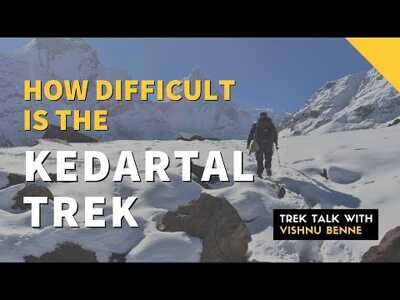
Trek Trivia
Why Pilgrims Throng at Gangotri
If you are visiting Gangotri in May-June, expect to see thousands of pilgrims at Gangotri. This happens especially during the Chardham yatra season. They throng here to see the source of the river Ganga, so sacred in Indian mythology.
It is said that King Bhagirath prayed to Lord Shiva for the salvation of the souls of his 60,000 sons. Shiva obliged and requested Goddess Ganga to release her water, which purified the ashes of Bhagirath’s sons. This mythological story elevated the status of the River Ganga as a means to purify one’s soul.

Leaving Mountains Better
Green Trails is our promise to leave the mountains better. We have removed over 1 lakh kilos of the waste left behind by others on trekking trails. Yet this is a small percentage of what we do. Green Trails dives into reducing the use of resources, reducing our carbon footprint and bringing about a change in the daily practices of our trekkers too.

Treks by Categories
Contact Us
080 468 01269
Mon to Fri - 9.30 AM to 7.30 PM
Sat and Sun - 9.30 AM to 6.30 PM
Bengaluru Office
139, Defence Colony Road, Defence Layout, Sahakar Nagar, Bengaluru, Karnataka - 560092
Dehradun Office
Mohabbewala, Titan Road, Near Titan Factory, Chandramani Khalsa Dehradun - 248002
© 2025 Indiahikes Private Limited
All images are copyrighted by their respective authors.
